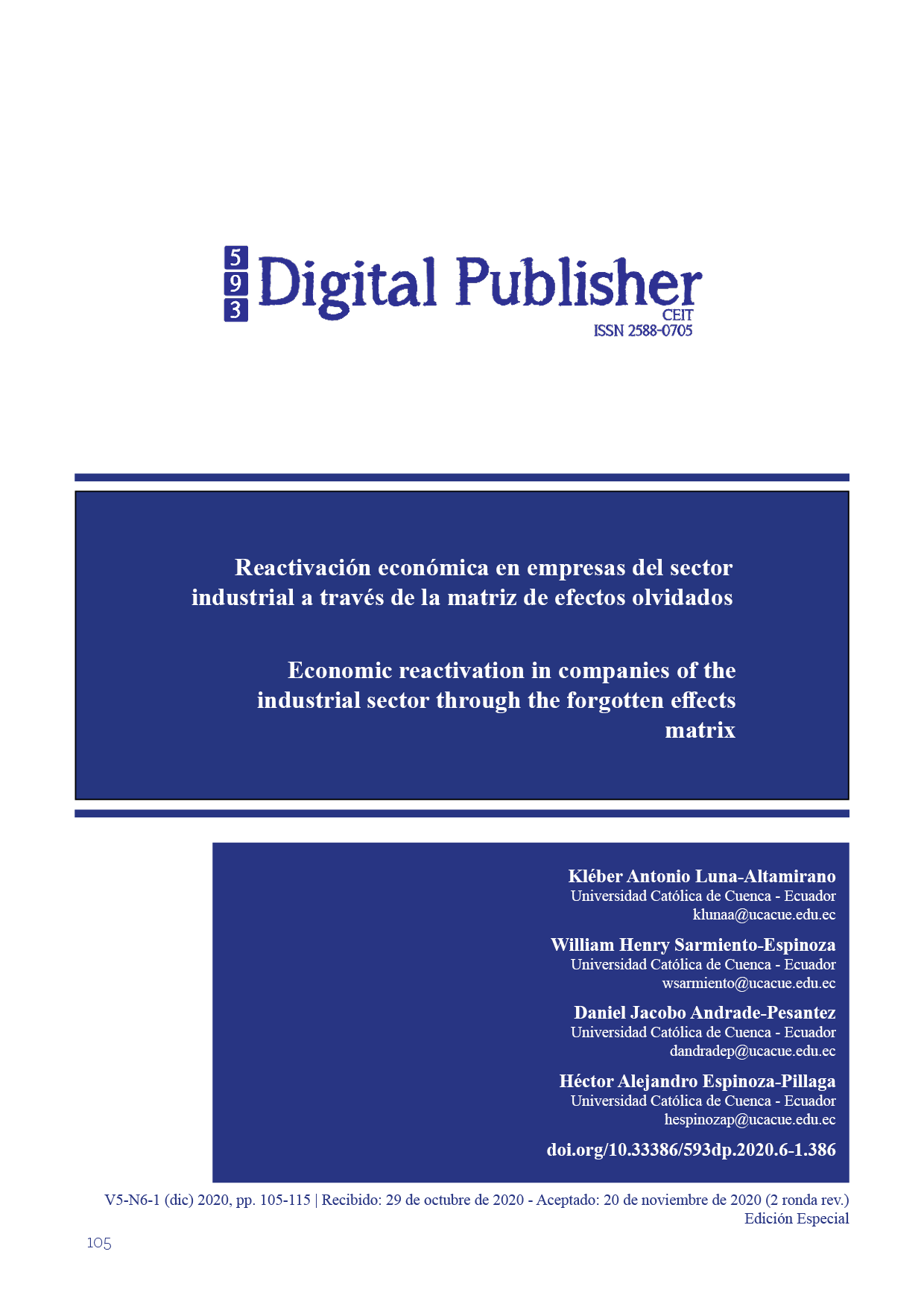Economic reactivation in companies of the industrial sector through the forgotten effects matrix
Main Article Content
Abstract
The city of Cuenca-Ecuador, recognized as the city of large industries, thanks to the contingent of these companies that make up the industrial sector, there has been an economic development within this canton. The problem of the investigation is the low production and commercialization of its products, translated into a loss of liquidity caused by the health emergency that the country is going through. The objective of the research is to develop the forgotten effects matrix by identifying actions and effects, thereby finding the forgotten variable, in order to try to mitigate this risk. From the methodological point of view, the study is aligned with the quantitative level, developing a square matrix of forgotten effects, with the support of the businessmen through their opinions, with this the results are obtained: The action Incorporation of biosafety elements affects on the effect gradual increase in production, through the forgotten effect or omitted variable "Personnel with health security". The use of this theory allows managers or owners to find the ideal way, in order to strengthen decision-making in this way to improve the sustainability of their organizations.
Downloads
Article Details

This work is licensed under a Creative Commons Attribution-NonCommercial-ShareAlike 4.0 International License.
1. Derechos de autor
Las obras que se publican en 593 Digital Publisher CEIT están sujetas a los siguientes términos:
1.1. 593 Digital Publisher CEIT, conserva los derechos patrimoniales (copyright) de las obras publicadas, favorece y permite la reutilización de las mismas bajo la licencia Licencia Creative Commons 4.0 de Reconocimiento-NoComercial-CompartirIgual 4.0, por lo cual se pueden copiar, usar, difundir, transmitir y exponer públicamente, siempre que:
1.1.a. Se cite la autoría y fuente original de su publicación (revista, editorial, URL).
1.1.b. No se usen para fines comerciales u onerosos.
1.1.c. Se mencione la existencia y especificaciones de esta licencia de uso.
References
Carro, J., Reyes, B., Rosano, G., Garnica, J., y Pérez, B. (2017). Modelo de desarrollo sustentable para la industria de recubrimientos cerámicos. Revista Internacional de Contaminación Ambiental, 33 (1), 131-139. doi. 10.20937/RICA.2017.33.01.12
Gutiérrez, M., Téllez, L., y Munilla, F. (2005). La Liquidez Empresarial y su Relación con el Sistema Financiero. Ciencias Holguín, XI (2), 1-10.
Kaufmann, A., y Gil-Aluja J. (1987). Técnicas operativas de gestión para el tratamiento de la incertidumbre. Barcelona-España: Hispano Europea.
Kaufmann, A., y Gil-Aluja J. (1989). Modelos para la investigación de efectos olvidados. Barcelona, España. Milladoiro.
Lazzari, L., Machado E., y Gento, A. (2001). Reflexiones acerca de las matrices de incidencia y la repercusión de efectos olvidados. Cuadernos de CIMBAGE, (4), 11-27.
Lozano, E., Torres. G. (2017). Modelo practico de Plan Estratégico de Mercadotecnia para Micro y Pequeñas Empresas de transformación en lagos de Moreno, Jalisco. Ra ximhai, 13 (3), 405-416
Luna, K., Sarmiento, W., y Andrade, C. (2019). Matriz de efectos olvidados: Caso sector industrial de Cuenca-Ecuador. Revista de Ciencias Sociales (RCS). XXV (2), 96-111.
Luna, K., y Sarmiento, W. (2019). Evaluación económica bajo el enfoque difuso: Caso industrias de la ciudad de Cuenca- Ecuador. Revista Venezolana de Gerencia, 24 (86), 547-562.
Reig, J., y González, J. (2002). Modelo borroso de control de gestión de materiales. Revista Española de Financiación y Contabilidad, 31(112), 431-459.
Rico, M., y Tinto, J. (2010). Herramientas con base en subconjuntos borrosos. Propuesta procedimental para aplicar expertizaje y recuperar efectos olvidados en la información contable. Actualidad Contable Faces, 13 (21), 127-146.
Rodríguez, J, Ramírez, M., y Díaz, V. (2008). Efectos olvidados en las relaciones de causalidad de las acciones del sistema de capacitación en las organizaciones empresariales. Revista de métodos cuantitativos para la economía y la empresa, (5), 29-48.
Salazar, R. (2012). El peso mexicano: la gestión de cobertura del riesgo cambiario mediante la Teoría de los Efectos Olvidados. Journal of Economics, Finance and Administrative Science. 17 (32), 53-73.
Sandoval, A., y Price M. (s.f.). Diseño de plan de mejora contínua aplicando la metodología PHVA en la empresa de Emulsiones y Asfaltos SAC.





